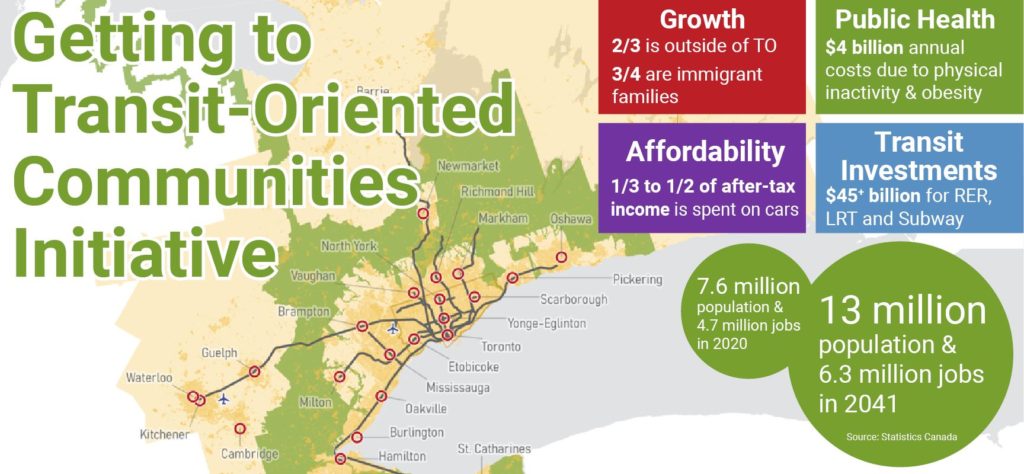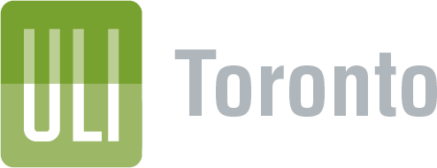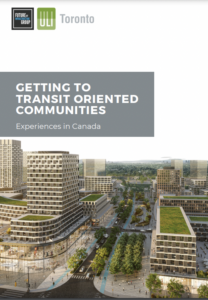Getting to Transit-Oriented Communities Initiative

Background
The Greater Toronto Region is the fastest growing metropolitan region in Canada and the US with 128,000 more people living in the region over the course of 2019. As with many cities across North America this growth puts strain on housing supply and local infrastructure. A greater emphasis on the connection between infrastructure and land use within Ontario through the development of Transit Oriented Communities provides an opportunity boost housing supply, reduce regional congestion, boost economic development, and reduce environmental impact.
Ontario has committed C$62 billion of investment in transit including dramatically expanding service on the regional rail system, new and expanded subways, new and expanded light rail, and enhanced bus services. With this historic investment being made transit infrastructure, there is an opportunity to leverage the value being created into transforming communities and providing a lasting benefit to all.
These investments involve federal, provincial, and municipal funding. Each level of government also plays different interconnected roles around planning, approvals, subsequent development around transit development, and public service provision. The picture becomes more complex with the local transit agencies, companies delivering infrastructure, real estate developers, landowners, local residents, transit agencies, community groups, and other stakeholders all having different priorities and perspectives on value. These competing perspectives can erode the overall value that should derive from these investments.
There is no singular precedent for the development of TOC in Ontario that can be reviewed as being truly integrated and transformative. While there are many good examples of transit adjacent or oriented development, we are yet to see an example that has been a catalyst for community level transformation. Integrating transit infrastructure with the community is a challenge in the following key areas:
- Value creation, value capture and who benefits
- Time of delivery to success
- Matching the vision with the expectation
The Urban Land Institute Toronto and the Future of Infrastructure Group worked together to organize four workshops based on three station developments in the Toronto region, and one transit system development in Montreal. A mix of expertise examined the challenges and learnings to provide recommendations on unlocking the potential of Transit Oriented Communities. This report provides a summary of the insights gathered.
Mission
Our mission is to nurture a collaborative city-building model to empower effective collaboration and alignment among public sector, private sector, non-profit and local communities. Through an integrated design-based strategic framework facilitated through a Professional Walkshop + Public Townhall combination, the program aims to shift development culture and accelerate implementation by amplifying synergies, creating new combined benefits, and fostering lateral thinking where solutions to one problem may reside in a different area.
Program Overview
The Greater Golden Horseshoe (GGH) is the fastest growing Global City Region in North America, with two thirds of the growth anticipated outside of the Toronto core, connected by rapid transit investments and lands owned by the province. TOC is the leading direction to expand healthy, convenient, high-quality live-work-play along subways networks, Light Rail Transit (LRT) and across existing GO networks, creating a new form of “Healthy City Region”, an affordable landing ground for new families to meet GTHA’s unprecedented population growth, where more than half of the new population are expected to be new immigrants.
With the right design, planning and execution, these TOC’s have the potential to provide the value of a “26 hour City”, where the ability to walk to daily needs eliminates the high cost of commuting and car-ownership, providing “extra hours” everyday that improves our quality of life and productivity, creates a nesting ground for high-quality jobs and employment, and moves our region towards a carbon-neutral future.
The coordinated delivery of a “20-min Walkable Neighbourhood” with a complete set of community facilities, parks and open space, affordable housing and high-quality live-work-play provides the secret sauce to unlock these values. The adjacencies and interrelated nature of these components have the potential to amplify synergies and create new combined benefits, but also requires a new way of problem-solving that involves concurrent decision-making, intense cross-sector collaborations and unprecedented innovation.
With thanks to the ULI Curtis Infrastructure Initiative for supporting this work, the Urban Land Institute Toronto and the Future of Infrastructure Group worked together to organize four workshops. The ULI Curtis Infrastructure Initiative aims to build a movement to promote infrastructure solutions that are equitable and resilient and that enhance long-term community value. By creating new global and strategic partnerships, providing technical assistance, building capacity at the local level, and acting as a feedback loop to promote the most innovative and effective best practices, the Curtis Infrastructure Initiative supports ULI’s mission to positively shape the future of the built environment for transformative impact in communities worldwide. A thoughtful approach to infrastructure planning and implementation addresses the pressing needs of today and improves diverse communities for the long term.
Year 1 – ULI FIG Getting to Transit-Oriented Communities Report
The Urban Land Institute Toronto and the Future of Infrastructure Group worked together to organize four workshops based on three station developments in the Toronto region, and one transit system development in Montreal. A mix of expertise examined the challenges and learnings to provide recommendations on unlocking the potential of Transit Oriented Communities. This report provides a summary of the insights gathered.
Year 2 – Building a Legacy in Brampton Report
In Year 2 of its TOC project, the Future of Infrastructure Group (FIG) and ULI Toronto focused on the TOC project in progress at the Shoppers World Mall and parking lot at Hurontario and Steeles in Brampton – the northernmost point of the new Hurontario light rail line coming north from Port Credit. FIG and ULI brought together leading experts from the developer and infrastructure communities and public sector to host workshops around themes critical to the success of transit-oriented communities, and to develop recommendations.
The analysis showed that building successful transit-oriented communities requires a balance between density, diversity, and design. These municipalities must become destinations themselves, mixing housing with employment, public services and local retail, parks, restaurants and other amenities, wrapped together with local character.
This report explores the different approaches Brampton has taken to help the different stakeholders work together to deliver a successful and vibrant transit-oriented community, documenting emerging best practices and the challenges that remain.

